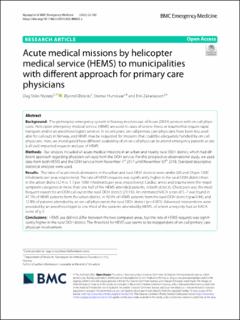| dc.contributor.author | Nystøyl, Dag Ståle | |
| dc.contributor.author | Østerås, Øyvind | |
| dc.contributor.author | Hunskaar, Steinar | |
| dc.contributor.author | Zakariassen, Erik | |
| dc.date.accessioned | 2022-12-29T12:48:51Z | |
| dc.date.available | 2022-12-29T12:48:51Z | |
| dc.date.created | 2022-09-13T09:44:18Z | |
| dc.date.issued | 2022 | |
| dc.identifier.issn | 1471-227X | |
| dc.identifier.uri | https://hdl.handle.net/11250/3039889 | |
| dc.description.abstract | Background The prehospital emergency system in Norway involves out-of-hours (OOH) services with on-call physicians. Helicopter emergency medical service (HEMS) are used in cases of severe illness or trauma that require rapid transport and/or an anesthesiologist’s services. In recent years, on-call primary care physicians have been less available for call-outs in Norway, and HEMS may be requested for missions that could be adequately handled by on-call physicians. Here, we investigated how different availability of an on-call physician to attend emergency patients at site (call-out) impacted requests and use of HEMS. Methods Our analysis included all acute medical missions in an urban and nearby rural OOH district, which had different approach regarding physician call-outs from the OOH service. For this prospective observational study, we used data from both HEMS and the OOH service from November 1st 2017 until November 30th 2018. Standard descriptive statistical analyses were used. Results The rates of acute medical missions in the urban and rural OOH districts were similar (30 and 29 per 1000 inhabitants per year, respectively). The rate of HEMS requests was significantly higher in the rural OOH district than in the urban district (2.4 vs. 1.7 per 1000 inhabitants per year, respectively). Cardiac arrest and trauma were the major symptom categories in more than one half of the HEMS-attended patients, in both districts. Chest pain was the most frequent reason for an OOH call-out in the rural OOH district (21.1%). An estimated NACA score of 5–7 was found in 47.7% of HEMS patients from the urban district, in 40.0% of HEMS patients from the rural OOH district (p = 0.44), and 12.8% of patients attended by an on-call physician in the rural OOH district (p < 0.001). Advanced interventions were provided by an anesthesiologist to one-third of the patients attended by HEMS, of whom a majority had an NACA score of ≥ 5. Conclusions HEMS use did not differ between the two compared areas, but the rate of HEMS requests was significantly higher in the rural OOH district. The threshold for HEMS use seems to be independent of on-call primary care physician involvement. | en_US |
| dc.language.iso | eng | en_US |
| dc.publisher | BMC | en_US |
| dc.rights | Navngivelse 4.0 Internasjonal | * |
| dc.rights.uri | http://creativecommons.org/licenses/by/4.0/deed.no | * |
| dc.title | Acute medical missions by helicopter medical service (HEMS) to municipalities with different approach for primary care physicians | en_US |
| dc.type | Journal article | en_US |
| dc.type | Peer reviewed | en_US |
| dc.description.version | publishedVersion | en_US |
| dc.rights.holder | Copyright 2022 The Author(s) | en_US |
| dc.source.articlenumber | 102 | en_US |
| cristin.ispublished | true | |
| cristin.fulltext | original | |
| cristin.qualitycode | 1 | |
| dc.identifier.doi | 10.1186/s12873-022-00655-z | |
| dc.identifier.cristin | 2051062 | |
| dc.source.journal | BMC Emergency Medicine | en_US |
| dc.identifier.citation | BMC Emergency Medicine. 2022, 22, 102. | en_US |
| dc.source.volume | 22 | en_US |
| dc.source.issue | 1 | en_US |

